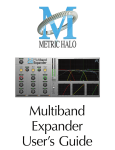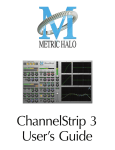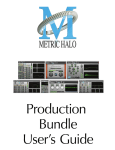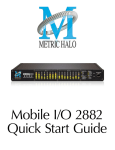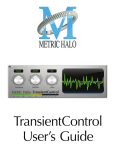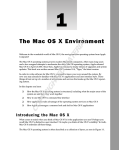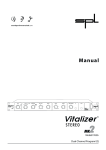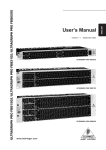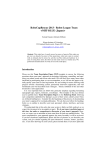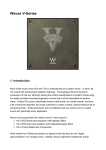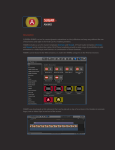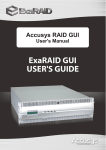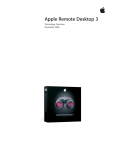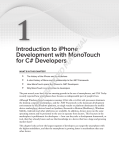Download MH HaloVerb User`s Guide
Transcript
HaloVerb Users Guide Metric Halo Revision: v1.0.5 Publication date Mon Jun 24 12:11:12 EDT 2013 Copyright © 2013 Metric Halo. MH Production Bundle, ChannelStrip 3, Character, HaloVerb, Multiband Dynamics, Multiband Expander, Precision DeEsser, and TransientControl are our trademarks. All other trademarks are the property of their respective owners. Table of Contents I. Installation .................................................................................................................................... 6 1. System Requirements ............................................................................................................ 8 2. Installation ........................................................................................................................... 9 Macintosh ........................................................................................................................ 9 Windows ....................................................................................................................... 13 Update Notification ........................................................................................................ 14 II. HaloVerb ................................................................................................................................... 15 3. Introduction ....................................................................................................................... 17 4. Operation .......................................................................................................................... 18 Control Knob ................................................................................................................. 18 Tooltip Control ............................................................................................................... 19 Graph Disclosure ............................................................................................................ 19 Output Level Meter ......................................................................................................... 19 Low and High Frequency Pre-filter ................................................................................... 20 Reverb Impulse Display .................................................................................................. 20 5. Processing .......................................................................................................................... 22 A Detailed Description .................................................................................................... 22 Prefilter .......................................................................................................................... 22 Reverb ........................................................................................................................... 22 Predelay ................................................................................................................. 22 RT60 ..................................................................................................................... 23 Damping ................................................................................................................ 23 Diffusion ................................................................................................................ 24 Width .................................................................................................................... 24 Wet/Dry Control ............................................................................................................. 24 Output Gain ................................................................................................................... 25 III. Working with Hosts ................................................................................................................... 26 6. Pro Tools (Mac/Win) ........................................................................................................... 28 Plug-in Window ............................................................................................................. 28 Key Commands .............................................................................................................. 29 7. AU Hosts (Mac) .................................................................................................................. 30 Logic ............................................................................................................................. 30 Plug-in Window ..................................................................................................... 30 IV. Appendices ............................................................................................................................... 31 A. Key Commands .................................................................................................................. 33 B. Service and Support ............................................................................................................ 34 C. Changelog ......................................................................................................................... 35 3 List of Figures 2.1. MH HaloVerb.pkg ..................................................................................................................... 9 2.2. Opening Dialog ......................................................................................................................... 9 2.3. License Agreement ................................................................................................................... 10 2.4. Accepting the License Agreement .............................................................................................. 10 2.5. Selecting the Installation Disk ................................................................................................... 11 2.6. Selecting the Installation Location ............................................................................................. 11 2.7. Giving the Installer Permission .................................................................................................. 12 2.8. Installation Complete ............................................................................................................... 12 2.9. MH HaloVerb Installer msi ....................................................................................................... 13 2.10. Opening Dialog ..................................................................................................................... 13 2.11. Permission to Write Files ........................................................................................................ 14 2.12. Installation Complete .............................................................................................................. 14 3.1. HaloVerb's User Interface ........................................................................................................ 17 4.1. Swept Knob ........................................................................................................................... 18 4.2. Spread Knob .......................................................................................................................... 18 4.3. Plus/Minus Knob .................................................................................................................... 18 4.4. Tooltip Control ....................................................................................................................... 19 4.5. Graphs Closed ........................................................................................................................ 19 4.6. Graphs Open ......................................................................................................................... 19 4.7. HaloVerb Output Level Meter .................................................................................................. 19 4.8. Low and High Frequency Pre-filter ........................................................................................... 20 4.9. Reverb Impulse Display .......................................................................................................... 20 4.10. Energy Time Curve ............................................................................................................... 21 5.1. Signal Flow ............................................................................................................................ 22 5.2. Pre-filters at 34 Hz and 9kHz ................................................................................................... 22 5.3. Predelay of 0 ms ..................................................................................................................... 23 5.4. Predelay of 45 ms .................................................................................................................... 23 5.5. RT60 of .1 Seconds .................................................................................................................. 23 5.6. RT60 of 7 Seconds .................................................................................................................. 23 5.7. Damping of 0% ....................................................................................................................... 24 5.8. Damping of 100% ................................................................................................................... 24 5.9. Diffusion of 0% ....................................................................................................................... 24 5.10. Diffusion of 75% ................................................................................................................... 24 6.1. Pro Tools Plug-in Window ...................................................................................................... 28 6.2. Compare Button ..................................................................................................................... 28 6.3. Automation Window ............................................................................................................... 29 7.1. Logic's Plug-in Window .......................................................................................................... 30 4 List of Tables 6.1. Pro Tools Key Commands ........................................................................................................ A.1. Tooltip Control ........................................................................................................................ A.2. Control Knob Modifiers ............................................................................................................ A.3. Numeric Field Modifiers .......................................................................................................... A.4. Meters .................................................................................................................................... A.5. EQ Transfer Functions .............................................................................................................. A.6. Pro Tools Key Commands ........................................................................................................ 5 29 33 33 33 33 33 33 Part I. Installation Table of Contents 1. System Requirements .................................................................................................................... 8 2. Installation ................................................................................................................................... 9 Macintosh ................................................................................................................................ 9 Windows ............................................................................................................................... 13 Update Notification ................................................................................................................ 14 7 1. System Requirements • Pro Tools™ (Macintosh): Pro Tools 10 or higher running on a Macintosh computer. This software supports Native and AAX DSP operation. • Pro Tools™ (Windows): Pro Tools 10 or higher running on a Windows computer. This software supports Native and AAX DSP operation. • Native: Any Macintosh DAW that supports Audio Unit plug-ins. • An iLok copy protection key and account. Please note that one Production Bundle license authorizes the software on any platform. 8 2. Installation Screenshots to illustrate the installation process are from the Production Bundle, but the process is the same for individual plug-ins. Macintosh Please note – The following graphics show installation on an OS 10.7 system; the process may be slightly different in other versions of the OS, but the basic concepts are the same. Small details such as file sizes shown may vary with subsequent releases. • Double-click the “MH HaloVerb.pkg” application Figure 2.1: MH HaloVerb.pkg • The installer dialog will appear: Figure 2.2: Opening Dialog Click “Continue”… • Now you will see the Metric Halo License Agreement: 9 Installation Figure 2.3: License Agreement After you have read it, click “Continue”… • Next click “Agree” to accept the License Agreement: Figure 2.4: Accepting the License Agreement • Now select the disk you would like the software to be installed to: 10 Installation Figure 2.5: Selecting the Installation Disk We recommend installing for all users unless you have a specific reason not to. Select the drive and click “Continue”… • Next, you have the option to select the location on the disk you would like the software to be installed to: Figure 2.6: Selecting the Installation Location We recommend that you use the standard installation location unless you have a specific reason not to. The standard locations are: 11 Installation • Plug-ins – (drivename)/Library/Application Support/Avid/Audio/Plug-Ins/MH Plug-Ins • Presets – (drivename)/Library/Application Support/Digidesign/Plug-In Settings Click “Install”… • You must now enter the name and password you use to log in to your computer, to give the Installer permission to write the software: Figure 2.7: Giving the Installer Permission Enter your credentials and click “Install Software”… • Once the installer has finished, you'll see this dialog: Figure 2.8: Installation Complete If you do not see the “Installation Successful” message, contact MH Support. • The final step is to go to http://www.ilok.com/ and install the software license to your iLok key. That’s it! Enjoy using HaloVerb! 12 Installation Windows There are two versions of each Windows installer: • Installers that end in .msi are intended for 32 bit versions of Windows, and install the 32 bit version of the plug-in(s). • Installers that end in _x64.msi are intended for 64 bit versions of Windows, and install the 32 bit and 64 bit versions of the plug-in(s). This allows you to run Pro Tools 10 or 11 on a 64 bit machine. These installation instructions refer to the 32 bit installer, but the process is the same for 64 bit installations. Please note – The following graphics show installation on an Windows 7 system; the process may be slightly different in other versions of the OS, but the basic concepts are the same. Small details such as file sizes shown may vary with subsequent releases. • Double-click the “MHHaloVerbInstaller.msi” application Figure 2.9: MH HaloVerb Installer msi • The installer dialog will appear: Figure 2.10: Opening Dialog After you have read the Metric Halo License Agreement, click the “I accept the terms of the License Agreement” checkbox and click “Install” • Windows will ask for permission to write the files: 13 Installation Figure 2.11: Permission to Write Files Click “Yes” to begin the installation. • Once the files have been written you will see the completion dialog: Figure 2.12: Installation Complete Click “Finish” to close the installer. If you do not see the “Installation Successful” message, contact MH Support. • The final step is to go to http://www.ilok.com/ and install the software license to your iLok key. That’s it! Enjoy using the Metric Halo Production Bundle! Update Notification HaloVerb will automatically check to see if there's a newer version available (if your computer is connected to the internet). If so, the version number in the UI will turn into an update notice. Click on the notice and a browser window will open to our download page, where you may download the newest installer. 14 Part II. HaloVerb Table of Contents 3. Introduction ............................................................................................................................... 4. Operation .................................................................................................................................. Control Knob ......................................................................................................................... Tooltip Control ....................................................................................................................... Graph Disclosure .................................................................................................................... Output Level Meter ................................................................................................................ Low and High Frequency Pre-filter ........................................................................................... Reverb Impulse Display .......................................................................................................... 5. Processing .................................................................................................................................. A Detailed Description ............................................................................................................ Prefilter .................................................................................................................................. Reverb ................................................................................................................................... Predelay ......................................................................................................................... RT60 ............................................................................................................................. Damping ........................................................................................................................ Diffusion ........................................................................................................................ Width ............................................................................................................................ Wet/Dry Control ..................................................................................................................... Output Gain ........................................................................................................................... 16 17 18 18 19 19 19 20 20 22 22 22 22 22 23 23 24 24 24 25 3. Introduction HaloVerb is a plug-in for digital audio workstations which provides a flexible algorithm-based reverb to add depth and ambience to your recordings. Features include: • Comprehensive controls • Graphic display of the Low and High Frequency Pre-Filters • Graphic display of the Reverb Impulse Figure 3.1: HaloVerb's User Interface 17 4. Operation The HaloVerb user interface uses a few different control elements to control all of the processing. These elements are: Control Knob Control Knobs are used to control the value of various continuous parameters of a process. There are three styles of encoders: Figure 4.1: Swept Knob The rings around these encoders sweep from a minimum to maximum value, from left to right. The exception is the Cutoff controls, which sweep from right to left. Figure 4.2: Spread Knob The ring around this encoder starts at 12 o'clock and spreads to both sides equally as the Stereo Width is increased. Figure 4.3: Plus/Minus Knob The rings around these encoders start at 12 o'clock and sweep to either side. These knobs are used for Wet/ Dry and Gain controls. You can change the value of each knob in a number of different ways. Click and drag the knob to change the value continuously. Dragging up or to the right will increase the value, while dragging down or to the left will decrease the value. If you hold down the Mac ⌘ (Command) key or Windows Control key when you click, you will be able to adjust the value with finer precision. If you hold the Mac ⌥ (Option) key or Windows Alt key when you click, the knob will reset to its default value. You may also double-click a knob to reset it. Click on the number (readout) of the knob to display a text entry field that allows you to type in a number directly. The pop-up will remain active until you dismiss it by clicking somewhere else or hitting the return, enter, tab, Mac ⌘. (Command + .), Windows Alt key or ESC keys. Hit return or enter to confirm the value 18 Operation and dismiss the pop-up. Hit the tab key to confirm the value and display an entry field for the next control. ⇧tab (Shift + tab) will display the entry field for the previous control). Hit the Mac ⌘. (Command + .), Windows Control. (Control + .) or ESC (Escape) to dismiss the pop-up and cancel the change. When you enter a number into the pop-up entry, you can use a couple of abbreviations: “k” multiplies the number by 1000 and “m” divides the number by 1000. So if you want to enter 16,500 Hz you can just type 16.5k. Tooltip Control Figure 4.4: Tooltip Control This button toggles the tooltip display. When enabled, tooltips wil be shown when the mouse hovers over a control. When the tooltip display is disabled, you may still see tooltips by holding down the ? key and hovering over a control. Graph Disclosure Figure 4.5: Graphs Closed Figure 4.6: Graphs Open This button toggles the display of the high frequency pre-filter and reverb impulse displays. Output Level Meter Figure 4.7: HaloVerb Output Level Meter 19 Operation The HaloVerb provides a meter displaying the output level of the plug-in. The top segment of the meter (above 0dB) is used as a clip indicator and is illuminated red if the output section of the processor detects an over. The clip light remains illuminated until you click on the meter. Mac ⌥ (Option)–click or Windows Alt-click the meter to reset the clip light. A Note About Clipping Indicators: The clip lights do not mean that the plug-in is clipping; it means that the audio level in the DSP is currently over 0 dBFS. If you do not lower the signal level you run a chance of actually clipping the input of another processor or D/A convertor. Low and High Frequency Pre-filter Figure 4.8: Low and High Frequency Pre-filter The pre-filter graph is a visual representation of the filter shape as set by the Cutoff Hz and Cutoff dB controls for the Low and High filters. As these controls are changed, the dots shows the knee freqencies and levels. You may also click and drag the dots to change the filter placements. Reverb Impulse Display Figure 4.9: Reverb Impulse Display The reverb impulse display gives you a visual indication of what the reverb parameters are doing. The horizontal axis represents time (up to .5 seconds) and the vertical axis represents unscaled level. Clicking on the display will toggle between the Reverb Impulse Display and Energy Time Curve. 20 Operation Figure 4.10: Energy Time Curve 21 5. Processing A Detailed Description In this chapter we'll discuss how the controls work. Input Pre-filter Wet/Dry Control Reverb Output Gain Output Figure 5.1: Signal Flow The block diagram above illustrates the overall structure of the processing system provided by HaloVerb. The diagram does not indicate the metering blocks. Now lets examine the various processing blocks indicated in the diagram. Prefilter These controls set the frequency and level of the shelving pre-filters. Using these controls allows you to tailor how much low and high frequency material is removed before the signal enters the reverb process. Figure 5.2: Pre-filters at 34 Hz and 9kHz Reverb Let's take a look at what HaloVerb's parameters do, using the Reverb Impulse display. All controls will be at the factory default except the control being discussed, so that you can see how that control changes the reverb characteristics. Please note that some combinations of settings will look similar in the impulse display, but will sound very different. Predelay The Predelay control sets the time in milliseconds before the first reflection of the reverb is heard, up to a maximum of 170 ms. When looking at the Reverb impulse, the predelay is seen as the time between the left side of the window and the beginning of the impulse: 22 Processing Figure 5.3: Predelay of 0 ms Figure 5.4: Predelay of 45 ms RT60 The RT60 control sets the overall reverb time in seconds; RT60 is a standard measurement of how long it takes the acoustic energy in a room to fall below 60 dB. When looking at the Reverb impulse, changes in the RT60 will be seen as a “thickening” of the reverb tail: Figure 5.5: RT60 of .1 Seconds Figure 5.6: RT60 of 7 Seconds Damping The Damping control sets how much of the reverb signal is removed before being fed back into itself as a percentage. Low damping settings can lead to a ringing, metallic sound. 23 Processing Figure 5.7: Damping of 0% Figure 5.8: Damping of 100% Diffusion The Diffusion control determines how dense the reverb is. A low diffusion setting emphasizes individual echos, while a higher diffusion “pushes” the echos together and thickens the reverb. Some higher settings will cause the reflections to decreasedue to phase cancellation. Figure 5.9: Diffusion of 0% Figure 5.10: Diffusion of 75% Width The Width control is only available when using HaloVerb as a stereo plug-in. Width allows you to vary the “spread” of the reverb from mono (panned to the center of the image) to full stereo. Wet/Dry Control The Wet/Dry control sets the mix between the reverb (wet) and original (dry) signals as a percentage. Setting this control to 0 (full dry) lets no reverberated sound through. Setting this control to 100 (full wet) lets only reverb pass; you would want to use this setting when inserting HaloVerb on an aux bus. If you are inserting HaloVerb directly on an input or bus, use this control to balance the original audio and reverb. 24 Processing Output Gain The Gain control allows you to vary the final output level of HaloVerb by ±20dB 25 Part III. Working with Hosts Table of Contents 6. Pro Tools (Mac/Win) ................................................................................................................... Plug-in Window ..................................................................................................................... Key Commands ...................................................................................................................... 7. AU Hosts (Mac) .......................................................................................................................... Logic ..................................................................................................................................... Plug-in Window ............................................................................................................. 27 28 28 29 30 30 30 6. Pro Tools (Mac/Win) Your Pro Tools software provides a standard interface for controlling various aspects of AAX plug-ins. While you should refer to your Pro Tools documentation for a complete description, we will summarize the most important points here. If you wish to use a plug-in on multiple channels in your mix, you should Mac ⌥ (Option) or Windows Alt insert the plug-in on the desired channels and ensure that the plug-in is inserted on the same insert point on every channel (e.g. ensure that the plug-in is on insert “a” for every channel). This will allow you to take advantage of a number of time saving features provided by Pro Tools. Plug-in Window The illustration below shows the standard Pro Tools plug-in window. Figure 6.1: Pro Tools Plug-in Window You can click on the channel name pop-up in the upper left hand corner of the window (labeled “Audio 1” above) to switch from channel to channel. The next pop-up in the window (labeled “b” above) allows you to switch to another insert on the same channel. You would use this to switch to another plug-in on the same channel. The bypass button allows you to bypass the effects of HaloVerb. When the bypass is turned on the plug-in will have no effect on the audio track. The Pro Tools editor/librarian button (the small downward pointing triangle) provides access to a pop-up menu that allow you to manage presets and libraries of setting for the HaloVerb. Use this menu to save libraries or open groups of libraries. See your Pro Tools documentation for more information. The preset library pop-up menu (labeled “factory default” above) shows the active preset name (in italics if the current settings do not match the library). Click this pop-up to select from the available presets. The “Compare” button indicates when the controls have changed for the current preset settings. Click this button to toggle between your current settings and the preset settings. Figure 6.2: Compare Button Clicking the “Automation” button causes Pro Tools to display the plug-in automation configuration dialog box: 28 Pro Tools (Mac/Win) Figure 6.3: Automation Window This dialog box allows you to enable any or all of the processing parameters for automation. When a parameter is enabled for automation you will be able to record and play-back automated parameter changes directly from your Pro Tools session. If the channel that HaloVerb is inserted on has automation enabled HaloVerb will highlight the controls associated with the automated parameters: • • • • Off: No color Read: Green Touch, Latch, Write: Red Controlled via control surface: Blue Key Commands The following key commands are used to when clicking on controls: Command Display Automation Dialog Show Automation Breakpoint Set Parameter to Default Value Table 6.1. Pro Tools Key Commands Mac Key Sequence Windows Key Sequence ⌥⌘ (Option + Command)–click Alt + Control–click ⌥ (Option)–click or double–click Alt-click or double-click ⌃⌘ (Control + Command)–click 29 Control + Windows–click 7. AU Hosts (Mac) The Production Bundle is compatible with any Core Audio compatible host. Support for features like sidechains differ between hosts; please check your host's documentation for more info. As an example, we'll look at using the Production Bundle in Logic. Logic Logic provides a standard interface for controlling various aspects of AU plug-ins. While you should refer to your Logic documentation for a complete description, we will summarize the most important points here. If you wish to use a plug-in on multiple channels in your mix, you should click and drag the selection marquee over the desired channels in the Mixer, and insert the plug-in on any one of them; this will insert the plugin at the same insert point on every channel. Plug-in Window The illustration below shows the standard Logic plug-in window. Figure 7.1: Logic's Plug-in Window If you have inserted the plug-in as we suggested above you can click on the “Show Channel Strip” pop-up to switch between instances of the plug-in on different channels. The “Show Insert” pop-up allows you to switch to another insert on the same channel. You would use this to switch to another plug-in on the same channel. When the Link button (the button with the chain icon) is on, a single plug-in window is used to display all plug-ins. Turn this off if you would like to have multiple plug-in windows open at once. The View button is used to toggle between the generic AU user interface for the plug-in and the standard view provided by Metric Halo. The Bypass button allows you to bypass the effects of the plug-in. The effects of all the processing sections within the plug-in are removed from the audio chain when the plug-in is bypassed. The Compare button allows you to toggle between the current settings and the settings as they were before the last paramenter change. By using the Compare button you may “A/B” changes in settings. The left/right arrows move backward and forward between presets. The Logic preset menu (the pop-up menu with the small downward pointing triangle next to the left/right arrows) allows you to manage presets and libraries of settings for the plug-ins. Use this menu to save libraries or open groups of libraries. See your Logic documentation for more information. The Copy and Paste buttons allow you to copy settings from one instance of a plug-in and paste them into the same plug-in on other channels without creating a preset. The sidechain input pop-up menu allows you to select from any mono input or bus in your system and feed it to the internal sidechain bus within plug-ins that have sidechain support. You then use the sidechain routing buttons within the plug-in UI to assign the sidechain bus to the dynamics detectors. This menu is only present when a sidechain-enabled plug-in is viewed. 30 Part IV. Appendices Table of Contents A. Key Commands .......................................................................................................................... 33 B. Service and Support .................................................................................................................... 34 C. Changelog ................................................................................................................................. 35 32 A. Key Commands There are several key commands used as modifiers combined with mouse actions: Command Table A.1. Tooltip Control Mac Key Sequence Windows Key Sequence Show tooltips Hold ? down Hold ? down Command Table A.2. Control Knob Modifiers Mac Key Sequence Windows Key Sequence Fine control ⌘ (Command)-click and drag Reset to default value Command ⌥ (Option)-click or double-click Control-click and drag Alt-click or double-click Table A.3. Numeric Field Modifiers Mac Key Sequence Windows Key Sequence Confirm & dismiss numeric pop-up return, enter return, enter Confirm & move to previous entry ⇧-tab (Shift + tab) ⇧-tab (Shift + tab) Confirm & move to next entry tab Dismiss numeric pop-up & cancel ⌘. (Command + .), ESC change tab Control. (Control + .), ESC Command Table A.4. Meters Mac Key Sequence Windows Key Sequence Reset Clip ⌥ (Option)–click the meter Alt-click the meter Command Table A.5. EQ Transfer Functions Mac Key Sequence Windows Key Sequence Toggle band enable ⌘ (Command)–click or double-click frequency dot Adjust bandwidth (click then drag) ⌥ (Option)–click frequency dot Change filter type ⌘⌥ (Command + Option)–click frequency dot Access EQ TF settings ⌃ (Control) or right-click graph Command Display Automation Dialog Show Automation Breakpoint Set Parameter to Default Value Control-click or double-click frequency dot Alt-click frequency dot Control+Alt-click frequency dot Right-click graph Table A.6. Pro Tools Key Commands Mac Key Sequence Windows Key Sequence ⌥⌘ (Option + Command)–click Alt + Control–click ⌥ (Option)–click or double–click Alt-click or double-click ⌃⌘ (Control + Command)–click 33 Control + Windows–click B. Service and Support Metric Halo takes great pride in the reputation for customer service and support that we have built. If you have any problems, questions, or suggestions please get in touch with us at: • http://mhsecure.com/support • [email protected] • (727) 725-9555 Please keep us informed about your successes and projects. We love to hear from you! 34 C. Changelog Please note that this changelog incorporates changes for all plug-ins across all supported formats. 1.0.5: • • • • • • • • • • • • • • • • • • • • • Fix alignment issue with some UI elements in ChannelStrip [AU] Fix issue in some hosts where parameter updates may be lost Fix for potential crash on deinstantiation in Multiband Plugins [AU] Fix for crash in some hosts (specifically FCPX) due to initialization on a thread [AU] Fix meter reset for MultibandCompressor [AU] Fix meter reset for MultibandExpander [AU] Fix potential crash in HaloVerb [AU] Fix meter reset for Character Fix meter allocation for MultibandExpander Fix analysis buffer allocation for MultibandExpander Fix analysis buffer allocation for MultibandCompressor Fix analysis buffer allocation for De-Esser [AAX] Add support for PT11 and 64-bit build [AAX-Win] Implement full optimization for host code (decreases CPU usage) [AAX-Win] Implement 64-bit Installers Sign Binaries for PT 10.3.x / PT 11 Fix auto-suffixing of parameter readouts to deal with negative numbers [TransientControl] Fix (extend) range of the sustain parameter Fix locking for threaded plotter of crossover functions to avoid potential race condition and crash [Mac] Fix problem with signing 32-bit binaries (led to corrupted PT 10.3.x plugins) Fix Gain Reduction meters for PT reported meters (so that PT11 and control surfaces render them properly) 1.0.4: • • • • • • • • • Fixed potential problem with licensing code when plugin scanner opens and closes plugin very quickly Moved drawing of HaloVerb impulse response onto background thread for responsiveness Moved drawing of Multiband dynamic EQ response onto background thread for responsiveness Added caching for background image of plugin window to reduce CPU used for drawing static image Fixed incorrect interpretation of wet/dry parameter when computing HaloVerb impulse response display Optimized computing HaloVerb impulse response display Optimized redraw of EQ response curve Fixed problem with incorrectly showing that preset was changed (when it wasn't) via Compare button Deferred redraw of UI until host sends parameter changed message -- fixes PT UI pauses when changing certain parameters • Fixed problem with parameter notification that caused recording of automation for ChannelStrip to not function • Added work-around to fix problems with multi-parameter touch automation recording in Logic (worksaround Logic bug) 1.0.3: 35 Changelog • • • • • • • • • • • • • • • • • • • • Soft Interpolation of band Bypass in ChannelStrip EQ Fix slight transparency on some controls Fixed problem with tool-tip tracking Fixed problem with phantom mouse clicks after dragging beyond UI boundary Fixed problem with silent output from CS2/CS3 on some hosts with disconnected sidechain input Fixed problem with compressor gain state on instantiation ChannelStrip: removed recall of Bypass from preset state (to match standard PT behavior) Add support for Mac OS 10.5 Add support to cancel text entry with ⌘. (Command + .) [Control. (Control + .) on Win] Fixed interpolation to support bit-clean bypass Fixed noise problem with LF high-pass filters Fix problem with tooltips appearing even if window is covered by another window or is hidden Added a preference to control auto-enable of bands to the Transfer Function popup menu in ChannelStrip 3 Fixed interpolation in ChannelStrip: • Stereo EQ bands • Compressor/Limiter threshold • Stereo Gate Fixed interpolation in Multiband Dynamics: • Compressor/Limiter threshold Knee control in ChannelStrip 3 is hidden when not in "MIO" character mode Added version number reporting and update notification Initial release for Windows AAX Initial release for Macintosh AU Initial release of ChannelStrip 3 for GarageBand 1.0.2: • Fixed issue with grunge when DSP is filled with MH Precision De-esser • Further optimized CS3, Precision De-esser, and MH MultibandDynamics, leading to an increase in instance counts • Fixed bit-cleanliness on bypassed CS3 blocks -- so now CS3 with phase invert nulls with unprocessed audio 1.0.1: • • • • • • • • • • • • Substantial optimization of the processing code, especially for HDX Accurate Cycle Counts for HDX Enhanced control surface page table layouts Fix for some corner case bugs that apparently can cause a DSP crash on heavily loaded systems Additional interpolation of various parameters in the plugins to provide glitch free parameter changes Fixed a conflict between CoreGraphics and DAE that can lead to DAE errors (DSP + Native), CPU Spiking or CPU overloads (Native) Fixed a filter stability issue for high session sample rates Fixed an issue where the average trace in the analyzer view can get stuck Reduce the size on disk and in memory of the plugins Fixed some missing control surface metering support and clip detection Fixed some small graphic anomalies Fix for detector for classic compressor in CS3 when Side-Chain filter is enabled 36 Changelog • Signed installer for Mountain Lion compatibility 1.0: Initial release for Macintosh AAX 37





































